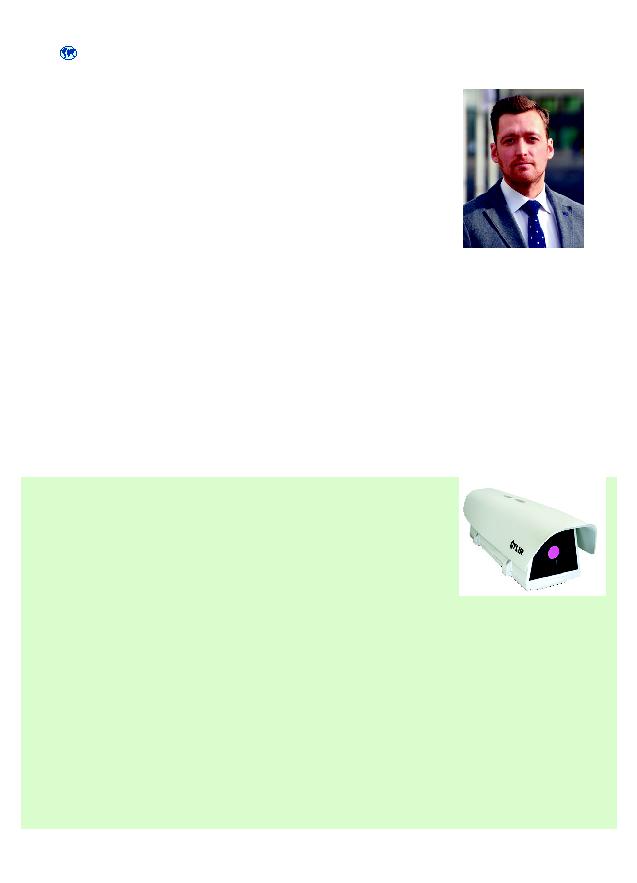
8 · d e t e k t o r i n t e r n a t i o n a l
Security Technology
Market
Big opportunities for Physical Security
Business Growth over the Next 3 Years
Stockholm, Sweden
Northbrook, Il (USA)
Memoori´s world report on the Physical Security Busi-
ness 20202025 shows that the industry in the last two
years has faced serious challenges, none more so than
the Covid-19 pandemic, but it has proved to be robust
and will return to significant growth by 2025.
The thermal imaging market is projected to grow from
3.6 billion US dollars in 2021 to 4.7 billion dollars by
2026, growing at a CAGR of 5.5 percent during the fore-
cast period.
Memoori estimate that the total
value of world production of
Physical Security products at fac-
tory gate prices in 2020 was 31.7
billion dollars, a decline of over
7.5 percent compared to 2019.
However, the next three years offer
big opportunities for healthy com-
panies, especially the companies
of size, according to the CEO of
Memoori, James McHale.
"Major manufacturers will
continue to increase their share
of the business at the expense of
small & medium size companies.
Size matters in Physical Security,"
he states.
Big business means
good business
James McHale means that big
businesses will be able to sustain
lower rates of growth during what
will surely be lean years between
2021 to 2023, but still invest in
R&D and new technologies.
"The global pandemic will
have created thousands of
struggling companies, that are
already drained of sufficient
cash to survive and governments
will soon be turning off the life
support that has kept them alive.
This will have the knock-on effect
of many not having the capability
to finance new, or even upgrade
security systems."
"However, Verticals Markets
such as Public Surveillance (Smart
Cities), Hospitals, Education
& Transport are often publicly
financed and are more able and
committed to investing in physi-
cal security projects. They offer
the best opportunity for growth
over the next few years."
Growth for Security
as a Services
Demand for Video Surveillance
as a Service (VSaaS) and Access
Control as a Service (ACaaS) will
grow.
"These services are offering
buyers lower operating costs and
less upfront investment as they
can pay monthly. They will have
a significant impact on traditional
routes to market over time, chal-
lenging current manufacturer/
distributor/installer/end-user
routes," claims James McHale.
"Added to this, Technology
such as AI video analytics is rap-
idly increasing the performance of
VSaaS. This, in itself, is contrib-
uting to growth and the attrac-
tiveness of managed services."
Fastest growth in Asia
Finally, the geographic distribution
of physical security demand will
become a major factor over the
next three years, according to the
report from Memoori that points
out China as the fastest growing
market. As an example, video
surveillance product manufacturer
Hikvision reported a sales increase
of nearly 40% led by domestic
growth of 46% for the first six
months of 2021.
"The rest of Asia will also
increase its share of the business,
whilst North America will strug-
gle to retain its share and Europe's
share will decline," concludes
James McHale.
The key factors driving the growth
of the market include increas-
ing government expenditure on
the aerospace & defence sectors,
increasing adoption of thermal
imaging in the automotive indus-
try, growing R&D investments by
companies, governments, and capi-
tal firms for developing innovative
thermal imaging solutions, amongst
other things.
This latest report on the subject
from Marketsandmarkets finds that
the thermal cameras segment is
set to account for the largest share
of this market during the five year
forecast period from 2021 to 2026.
On the basis of product type,
the report segments the market into
three categories--thermal cameras,
thermal scopes, and thermal mod-
ules. The thermal cameras segment
held the largest share of the thermal
imaging market in 2020 and, ac-
cording to the analysts, is expected
to continue this growth during the
forecast period. Several reasons,
such as an electronic image of high-
quality precision produced in less
time and the availability of different
types (handheld, mounted, and
standalone) and various micro-
and nano-sizes, contribute to this
dominance.
Security and surveillance
to take the lion's share
Similarly, based on applications,
the report separates the market into
security and surveillance, monitor-
ing and inspection, and detection
and measurement. The security
and surveillance segment held the
largest share of the thermal imaging
market during the forecast period.
Rapid urbanisation increases the
demand for advanced thermal
imaging solutions for security and
surveillance applications. The rise
in conflicts and terrorist activities
among countries also increase the
demand for well-equipped systems
to monitor country borders from
illegal intrusion and protect the
country and its citizens.
North America
leads the way
Among all regions, North America
accounted for the largest share of
the thermal imaging market and
the research expects this trend to
continue over the forecast period.
The region is home to some major
producers of thermal imaging com-
ponents, such as thermal cameras,
scopes, and modules. The US is the
major contributor to this region
and accounts for ~89% of the total
thermal imaging market share in
North America. The growth of the
thermal imaging market in this
region is attributed to the presence
of numerous manufacturers and
distributors, the low cost of thermal
imaging components, and the
increasing government expenditure
in the aerospace & defence sector.
Some of the key companies
operating in the market, and
named in the report by the analysts,
are: Teledyne Flir, Fluke Corpora-
tion, United Technologies, Axis
Communications, Xenics, and
Thermoteknix Systems.
James McHale, CEO of Memoori.
The thermal cameras segment held the
largest share of the thermal imaging
market in 2020.
Thermal imaging market heats up to 4.7 billion dollars by 2026
